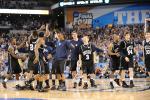The Shift: How Athletic Communications Is Changing
Posted At: October 10, 2011 12:19 PM
by Meghan Rodriguez
 In April 2010, a basketball team from a small private university in Indianapolis made national headlines at the NCAATournament. The Butler Bulldogs rose from their fifth-seed underdog status to face off against Duke in the championship, the fourth-winningest team in men’s basketball history.
In April 2010, a basketball team from a small private university in Indianapolis made national headlines at the NCAATournament. The Butler Bulldogs rose from their fifth-seed underdog status to face off against Duke in the championship, the fourth-winningest team in men’s basketball history.
Butler left the tournament as runners-up, while Duke won its fourth NCAA title. However, the Bulldogs became the poster children for Butler University. According to a report in the Indianapolis Business Journal, the number of applications to Butler rose 41 percent — a total of 9,357 more — compared to the same time the previous year.
Butler returned to the tournament in 2011, dropping the title this time to Connecticut. During the period of mid-March to mid-June, the university “garnered an estimated publicity value of $512,382,703 through television, print and online news coverage. When factoring in social media, the audience surpassed 69 billion,” according to arelease from Butler’s Athletic Media Relations office.
Butler is an example of a Cinderella story. Its tournament run resulted in a favorable amount of positive publicity for the athletics program, as well as the school. Almost overnight, the sports information department of Butler went from promoting the basketball team to managing the mass media attention it was receiving.
The role of athletic communications departments is more crucial than ever as college athletics become more of a big-time business. Sports information directors are no longer viewed simply as distributors of statistics and game notes. Associate Commissioner for Public Relations of the Southeastern Conference (SEC) Charles Bloom said the industry is shifting away from the title sports information director.
“I think that there was a point in time when the term was the representative name for our profession. I think that the industry has changed such that we have become much more active in the communication process, whether it’s public relations, serving as the mouthpiece for our coaches and administrators, creating messaging points or taking care of our administrators and coaches in crisis situations. I think that’s good for us in the profession in that the CEOs consider us to be more of an integral part to the organization than ever before,” Bloom said.
Athletic communications directors at Butler were fortunate in the fact that the Bulldogs basketball team self-promoted the program through its underdog status. But what about colleges and universities whose games aren’t televised weekly; are the media relations directors’ roles any different when they’re promoting the swim team at a Division II college as opposed to a top-ranked football team?
Erik Christianson, director of public relations for the NCAA, feels that the priority is to tell a story.
“It should be to tell the stories of student-athletes every day,” Christianson said. “So while there will always be a need for statistics, game notes and those other elements that are related to sports information, the primary purpose should be to use that platform of athletics to tell a story. At the end of the day, it’s to tell that important story that is bigger than just sports.”
That’s not to say that there isn’t a need for promoting other athletic teams at major colleges and universities. “Before I came to the SEC, I worked at East Carolina University, which is a mid-major school,” Bloom said. “At ECU I had the sports information director role and one of my main jobs was to really gain as much media attention as I could. Whereas when I came to the SEC, it’s a lot different; you’re more managing it. However, the focus is so much on football and issues of the day that the media try to make that I think we are still trying to promote our Olympic sports. We’re trying to promote message points that maybe the media doesn’t want to promote, but yet we’re trying to promote them anyway.”
Athletic media relations departments are also utilizing social media as a platform to promote and inform. It’s not unusual for a football team or baseball team to have its own Facebook page, managed by the athletic communications department, as a means of engaging with fans during games.
In Christianson’s role at the NCAA, he has realized the advantage of social media. “It’s a vital platform today for organizations, specifically colleges and their athletic departments, to communicate directly with fans,” Christianson said. “What’s important though is that social media is A platform, not THE platform.”
Colleges and universities have embraced using athletic programs as a recruiting tool for potential students in the same way Butler did. Administrations have realized that while academics may be first priority when choosing a school, campus life also plays a significant role.
“Athletics needs academics,” Bloom said. “Academics needs athletics. If a school wants to recruit top students to their campus, one of the selling items is campus life and that includes going to athletic contests.”
As college athletics continue to grow, so will the roles and philosophies of athletic communications professionals. Whether they are promoting track and field at a small school or a basketball team such as Butler, it’s important to remember what their priority is.
“We want people to understand why student-athletes are competing,” Christianson said. “We want them to understand how they benefit from that, how the campus benefits and the values athletics brings to colleges or universities.”


